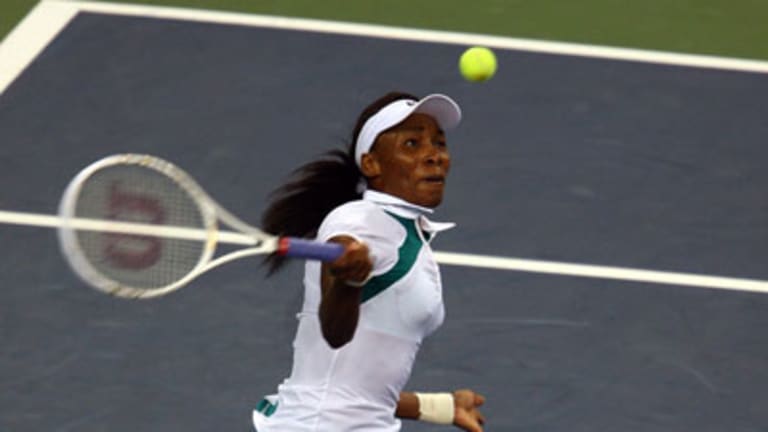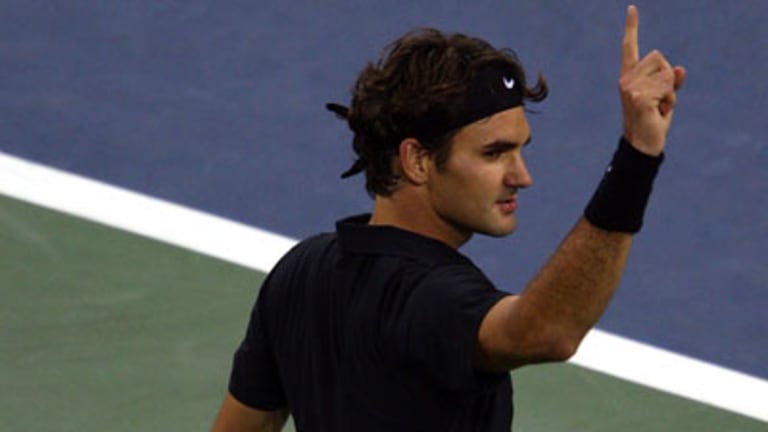The night session is old hat to many Open fans. We’re all a little tired of listening to Ted Robinson tell us that “crazy things happen in New York late at night,” as if a bunch of tipsy yuppies were preparing to hurl garbage cans through storefronts in Queens. Still, even 30 years after it was instituted at Forest Hills, tennis under the lights is what separates the Open from its two closest competitors, Wimbledon and the French Open, neither of whom have ever gone electric.
They’re missing out, because the sport gets a cosmopolitan makeover during the course of a New York evening. This isn’t a staid country club or a jocky public park. Night tennis at Flushing is a high-gloss urban American scene—it looks sharp, smells like money, and includes an international cast of characters. Even midtown Manhattan looks like a scuzzy freak show by comparison. Out on the grounds, in the shadow of the Enduring Monstrosity known as Ashe Stadium, we stream past brightly lit side courts and catch glimpses of ancient legends—man, do those guys’ games go downhill, just like the rest of us—yucking it up next to dead-serious juniors with ever-more-unpronounceable names. Can you say Uladzimir Ignatik or Anastasia Pavlyuchenkova three times fast? You may need to learn.
Then it’s time to head inside, past the shiny outdoor Red Star Café, where red-faced tennis fans from around the country hit on each other over $6 Heinekens. At night, the inside of the Monstrosity is not without glitter. Too massive and wide-open during the day, it becomes more comprehensible under a night sky, even intimate (in a titanic, American sort of way, of course). You hate to admit it, but by the time you take your seat, you feel slightly privileged to be part of it. Taking in the scene from the press section last night—look for the jeans and sneakers if you want to find us—you could turn your head left and come face to face with Larry David’s gleaming dome at the far side of the arena. Next to him is a sort-of-recognizable Jerry Seinfeld. From there you move your eyes right, past the Lexus, American Express, Continental Airlines, and New York Times logos, along rows of luxury suites filled with blue button-down shirts, dark blazers, and more gleaming domes—these bald heads somehow look expensive—busily scarfing and quaffing. Everyone’s got to eat, right? So why does this sight disgust me?
Finally, you turn your head further right and you come upon another highly familiar gleaming dome, in the TV booth: it’s Andre Agassi. As much of a star as Andre is, he's not the summit of glamour on this evening. That is located just to his right. There, in the front row of his box, a man with plenty of hair sits alone, ramrod-straight, staring forward, hands folded in his lap, unsmiling: It is Donald Trump. Now this is a night session.
On the court below, two young women look as grave as Le Donald. Venus Williams, in the shortest green shorts ever seen on a tennis court, has come out playing passive, unsure tennis—it’s clear she’s fallen to earth after her soaring all-out attack against Ana Ivanovic in the last round. Tonight, Williams is being kept at bay by Jelena Jankovic, whose ground strokes are smooth, deep, and have just enough variety and surprise to frustrate Williams and throw off her shaky forehand. Williams’ service motion is also funky in the early going; she’s mistiming her swing and pulling down too soon. Jankovic, meanwhile, is making inroads by wrong-footing Williams with her down-the-line counterpunches. From my view along the baseline, you can see just how low Jankovic gets for each ball, and how much she torques—I’ve never seen anyone open up their whole body as quickly and violently during a stroke. She doesn’t move into the ball so much as jump straight up, twist and hit, and then fall straight down in the same spot. From up close, it looks half-athletic, half-balletic.
Williams rights the ship in the second set. She finds her way to the net, where she punishes Jankovic’s floating defensive slices with her swinging volley, and uses her serve well on important points. One thing I notice while watching Venus on the baseline is how difficult she is to fool, to wrong-foot for a clean winner. There have always been fast players in tennis, but has anyone ever recovered and turned on a dime the way Venus does? “Turn” is the wrong word, actually, because she always looks ready to move in two directions at once.
In the third set, the intensity is palpably higher. Suddenly, Williams and Jankovic are efficient with their service games, holding 12 straight times (how often does that happen in a women’s match?). Both players have their share of hits and misses; Venus will send a forehand long and then cover it up an ace. Jankovic has trouble staying consistent when she’s not counterpunching; she’s one of those players, like Lleyton Hewitt, who thrive on the run but who is less sure of how to create from the middle of the court.
Still, the night belongs to Jankovic. She laughs along with the rowdy Serbian contingent at the top of the stadium, says something to Seinfeld, smiles after a painful split, and even flashes a conspiratorial grin at a ball boy after hitting a winning passing shot. Few players this side of John McEnroe have kept their emotions so close to the surface and still maintained their focus the way Jankovic does.
The match boils down to a tiebreaker, as these things often do. Venus wins by playing it smart. In other words, she plays it safe. At key junctures during this Open, I’ve noticed that the more experienced pros have gone for a little less and let their opponent try to dictate under pressure. Venus had been banging 120 m.p.h. serves a couple minutes earlier; in the tiebreaker, she spins her first two in. She doesn’t attack during the rallies, and it’s Jankovic, unused to forcing play, who starts to miss. The score is 5-1 in a matter of minutes. In the end, Venus turns the tables one more time and comes forward to knock off a trademark swinging volley for the match.
Jankovic charms the crowd with a gracious on-court interview and is her usual unflappably goofy self in the presser afterward. She’s subdued and philosophical, in a kind of lost-in-translation way. The first question is, “Was that fun out there?” Jankovic answers with a smile: “It’s not funny anymore.” She says she loves having supporters, loves the atmosphere out there, and is trying to stop doing splits—she claims she doesn’t know how she got started doing them. Jankovic is the best combination that fans can hope for: She’s not a star or a diva; she’s just a tennis player with a naturally winning personality, who likes doing what she does.

